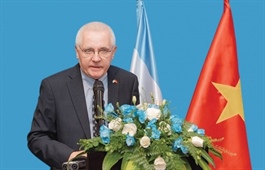Ba Ria-Vung Tau emerging as new magnet
Ba Ria-Vung Tau emerging as new magnet
Propelled by synchronised planning and robust infrastructure development, the Ba Ria–Vung Tau area – now part of the greater Ho Chi Minh City region – is emerging as one of Vietnam’s most dynamic investment destinations, drawing major players across strategic sectors, particularly property.
According to former Ba Ria–Vung Tau People’s Committee, the former province recorded a significant surge in total registered capital during the first half of the year. Newly pledged and supplementary capital from both domestic and overseas sources reached approximately VND109 trillion (equivalent to $4.3 billion), up 66.47 per cent on-year.

The Bien Hoa-Vung Tau expressway plays a vital role in regional connectivity Photo: Sun Group |
Foreign direct investment accounted for 60 per cent of the annual target, totalling $2.1 billion, while domestic capital constituted the remainder, fulfilling 93.8 per cent of the year’s plan.
A total of 26 ventures were approved during this period, with most concentrated in key industrial zones such as Phu My, Chau Duc, and Long Son. Global industrial players – including South Korea’s Hyosung, China’s BOE, Thailand’s SCG, and Sweden’s Trelleborg – have already established or expanded operations in the area.
Beyond manufacturing, coastal cities such as Vung Tau, Long Hai, and the rapidly growing Phu My are witnessing a boom in tourism and smart urban development. The influx of prominent developers is catalysing infrastructure upgrades and driving demand for residential, commercial, and hospitality land.
Ba Ria–Vung Tau’s property market is also gaining momentum thanks to a wave of major infrastructure projects. These include the Bien Hoa–Vung Tau Expressway, Phuoc An Bridge, a coastal route, and a proposed light rail line linking Ho Chi Minh City, Dong Nai, and Ba Ria–Vung Tau – a project initiated by Sun Group. These developments are expected to reduce travel times and fuel growth across the province.
Further boosting the province’s appeal is the proposed Cai Mep–Thi Vai Free Trade Zone. Located near Vietnam’s largest deep-sea port, this area is evolving into a regional hub for logistics, industrial facilities, and related services.
The planned administrative merger of Ba Ria–Vung Tau with Binh Duong and Ho Chi Minh City is also accelerating local activity. In recent months, land prices in areas such as Hac Dich, Tan Phuoc, and Phuoc Hoa wards have increased by 20–30 per cent since the start of the year, amid rising demand for well-planned residential plots.

The integration of Binh Duong and Ba Ria–Vung Tau provinces into Ho Chi Minh City opens a new chapter of growth in the real estate sector with large-scale urban projects Photo: Five Star Group |
With multiple projects receiving preliminary approval from local authorities, Sun Group plans to develop a world-class resort and urban ecosystem spanning Vung Tau, Long Hai, and Go Gang Island. It has also proposed key infrastructure works, including a light rail system from Ho Chi Minh City to Vung Tau, a bridge to Go Gang Island, an international cruise port, a world-standard hospital, and a beachfront plaza.
According to Dr Nguyen Tri Hieu, a banking and finance expert, new capital is flowing into core growth centres including Ba Ria, Vung Tau, Phu My, Long Dien, and Long Hai.
“Ba Ria–Vung Tau is located within southern Vietnam’s economic growth corridor, serving as a maritime gateway for the entire southeast region. It benefits from strong connectivity for both domestic and international trade. The province still has ample land reserves to support residential, commercial, and industrial expansion. More importantly, land prices remain relatively affordable compared to other satellite cities surrounding Ho Chi Minh City, such as Binh Duong and Dong Nai,” he said.
A long-established tourism destination, Ba Ria–Vung Tau benefits from a convergence of favourable factors that position it as a future property hotspot for the broader southeast region. The province also holds significant advantages in seaport and aviation infrastructure. The Cai Mep–Thi Vai deep-sea port cluster is one of the largest in the country, acting as a vital link in both the Moc Bai, Ho Chi Minh City, Bien Hoa, and Vung Tau economic corridor a well as the wider Trans-Asia corridor.
This maritime gateway plays a pivotal role in attracting overseas funding and accelerating industrial development. As a result, the influx of professionals and workers into local industrial areas is creating rising demand for housing and commercial space.
Meanwhile, the upcoming Long Thanh International Airport is expected to further enhance Ba Ria–Vung Tau’s appeal, consolidating its position as one of Vietnam’s most dynamic property markets.
| Son Huynh, co-founder, Civitas
On July 1, a landmark resolution streamlined the country’s provincial level administrative units from 63 to a more agile 34. This decisive reform, the most significant administrative overhaul since reunification, marks a strategic shift towards smarter, more effective governance and promises to unlock unprecedented opportunities for urban development and real estate investment, particularly in major economic powerhouses like Hanoi, Ho Chi Minh City, and Danang. For decades, Vietnam’s 63 provincial level units often led to fragmented planning, bureaucratic redundancy, and varying levels of administrative efficiency. The new resolution aims to address these challenges head on. By consolidating provinces and abolishing the district level, Vietnam is moving towards a unified two-tier local governance system: provincial level units (provinces and centrally governed cities) will act as the primary authority, directly overseeing commune level governance. This streamlined structure is designed to eliminate overlapping responsibilities, reduce bureaucratic layers, and foster more transparent reporting lines, ultimately leading to more responsive and efficient governance. The rationale is clear: a more cohesive administrative framework can better capture emerging opportunities in a rapidly evolving global economy. This restructuring is not merely about adjusting boundaries; it is about creating larger, more economically viable zones with enhanced appeal for infrastructure and industrial investment. The implications of this administrative reform for Vietnam’s real estate market and urban development are profound. The most immediate advantage is the emergence of larger, more competitive economic zones. Merging provinces allows for the combination of complementary strengths. For instance, land rich but cash poor province can merge with a more financially robust neighbour, enhancing capital efficiency and resource utilisation. This consolidation creates combined economic scales that are far more attractive to large-scale domestic and international investors, who are increasingly selective about their investment destinations. |
- 15:45 23/07/2025



